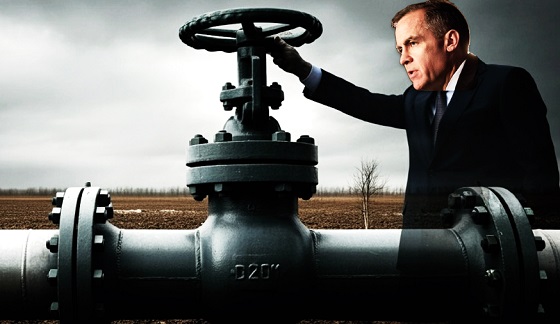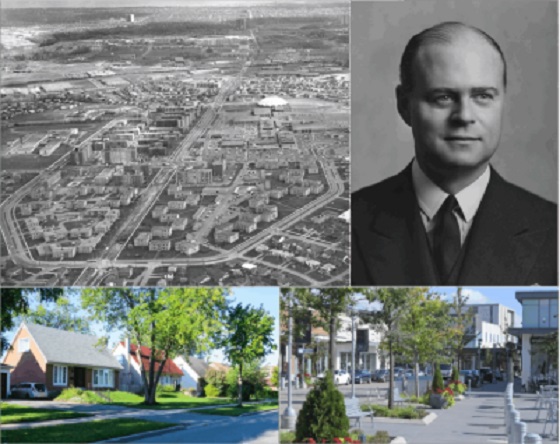C2C Journal
Natural Gas – Not Nuclear – Is the Key to Powering North America’s Future

From the C2C Journal
By Gwyn Morgan
After decades on the outs with environmentalists and regulators, nuclear power is being heralded as a key component for a “net zero” future of clean, reliable energy. Its promise is likely to fall short, however, due to some hard realities. As North America grapples with the challenge of providing secure, affordable and sustainable energy amidst soaring electricity demand, it is time to accept this fact: natural gas remains the most practical solution for powering our grid and economy.
Nuclear power’s limitations are rooted in its costs, risks and delays. Even under ideal circumstances, building or restarting a nuclear facility is arduous. Consider Microsoft’s much-publicized plan to restart the long-dormant Unit 1 reactor at Three Mile Island in Pennsylvania. This project is lauded as proof of an incipient “nuclear revival”, but despite leveraging existing infrastructure it will cost US$1.6 billion and take four years to bring online.
This is not a unique case. Across North America, nuclear energy projects face monumental lead times. The new generation of small modular reactors (SMRs), often touted as a game-changer, is still largely theoretical. In Canada – Alberta in particular – discussions around SMRs have been ongoing for years, with no concrete progress. The most optimistic projections estimate the first SMR in Western Canada might be operational by 2034.
The reality is that nuclear energy cannot scale quickly enough to meet urgent electricity needs. Canada’s power grid is already strained, and electricity demand is set to grow significantly, driven by electric vehicles and enormous data centres for AI applications. Nuclear power, even if expanded aggressively, cannot fill the gap within the necessary timeframes.
Natural gas, by contrast, is abundant, flexible, low-risk – and highly affordable. It accounts for 40 percent of U.S. electricity generation and plays a critical role in Canada’s energy mix. Unlike nuclear, natural gas infrastructure can be built rapidly, ensuring that new capacity comes online when it’s needed – not decades later. Gas-fired plants are cost-effective and capable of providing consistent, large-scale power while being capable of rapid starts and shut-downs, making them suitable for meeting both base-load and “peaking” power demands.
Climate-related concerns surrounding natural gas need to be put in perspective. Natural gas is the lowest-emission fossil fuel and produces less than half the carbon dioxide of coal per unit of energy output. It is also highly adaptable, supporting renewable energy integration by compensating for the intermittency of wind and solar power.
Nuclear energy advocates frequently highlight its zero-emission credentials, yet they overlook its immense challenges, not just the front-end problems of high cost and long lead times, but ongoing waste disposal and future decommissioning.
Natural gas, by comparison, presents fewer risks. Its production and distribution systems are well-established, and North America is uniquely positioned to benefit from the vast reserves underlying all three countries on the continent. Despite low prices and ever-increasing regulatory obstacles, Canada’s natural gas production has been setting new records.
Streamlining regulatory processes and expanding liquefied natural gas (LNG) export capacity would help revive Canada’s battered economy, with plenty of natural gas left over to help meet growing domestic electricity needs.
Critics argue that investing in natural gas is at odds with the “energy transition” to a glorious net zero future, but this oversimplifies the related challenges and ignores hard realities. By reducing reliance on dirtier fuels like coal, natural gas can help lower a country’s greenhouse gas emissions while providing the reliability needed to support economic growth and renewable energy integration.
Europe’s energy crisis following the recent reduction of Russian gas imports underscores natural gas’s vital role in maintaining reliable electricity supplies. As nations like Germany still phase out nuclear power due to the sheer blind ideology of their left-wing parties, they’re growing more dependent on natural gas to keep the lights (mostly) on and the factories (partially) humming.
Europe is already a destination for LNG exported from the U.S. Gulf Coast, and American LNG exports will soon resume growth under the incoming Trump Administration. Canada has the resources and know-how to similarly scale up its LNG exports; all we need is a supportive federal government.
For all its theoretical benefits, nuclear power remains impractical for meeting immediate and medium-term energy demands. Its high costs, lengthy timelines and significant remaining public opposition make it unlikely to serve as North America’s energy backbone.
Natural gas, on the other hand, is affordable, scalable and reliable. It is the fuel that powers industries, keeps homes warm and provides the stability our electricity grid needs – whether or not we ever transition to “net zero”. By prioritizing investment in natural gas infrastructure and expanding its use, we can meet today’s energy challenges head-on while laying the groundwork for tomorrow’s innovations.
The original, full-length version of this article was recently published in C2C Journal.
Gwyn Morgan is a retired business leader who was a director of five global corporations.
Business
Carney’s Energy Mirage: Why the Prospects of Economic Recovery Remain Bleak

 By Gwyn Morgan
By Gwyn Morgan
Gwyn Morgan argues that Mark Carney, despite his polished image and rhetorical shift on energy, remains ideologically aligned with the Trudeau-era net-zero agenda that stifled Canada’s energy sector and economic growth. Morgan contends that without removing emissions caps and embracing real infrastructure investment, Canada’s recovery will remain a mirage — not a reality.
Pete Townshend’s famous lyrics, “Meet the new boss / Same as the old boss,” aptly describe Canada’s new prime minister. Touted as a fresh start after the Justin Trudeau years, Mark Carney has promised to turn Canada into a “clean and conventional energy superpower.” But despite the lovey-dovey atmosphere at Carney’s recent meeting with Canada’s premiers, Canadians should not be fooled. His sudden apparent openness to new energy pipelines masks a deeper continuity, in my opinion: Carney remains just as ideologically committed to net-zero emissions.
Carney’s carefully choreographed scrapping of the consumer carbon tax before April’s election helped reduce gasoline prices and burnished his centrist image. In fact, he simply moved Canada’s carbon taxes “upstream”, onto manufacturers and producers, where they can’t be seen by voters. Those taxes will, of course, be largely passed back onto consumers in the form of higher prices for virtually everything. Many consumers will blame “greedy” businesses rather than the real villain, even as more and more Canadian companies and projects are rendered uncompetitive, leading to further reductions in capital investment, closing of beleaguered factories and facilities, and lost jobs.
This sleight-of-hand is hardly surprising. Carney spent years abroad in a career combining finance and eco-zealotry, co-founding the Glasgow Financial Alliance for Net Zero (GFANZ) and serving as the UN’s Special Envoy for Climate Action and Finance. Both roles centred on pressuring institutions to stop investing in carbon-intensive industries – foremost among them oil and natural gas. Now, he speaks vaguely of boosting energy production while pledging to maintain Trudeau’s oil and natural gas emissions cap – a contradiction that renders new pipeline capacity moot.
Canada doesn’t need a rhetorical energy superpower. It needs real growth. Our economy has just endured a lost decade of sluggish overall growth sustained mainly by a surging population, declining per-capita GDP and a doubling of the national debt. A genuine recovery requires the kind of private-sector capital investment and energy infrastructure that Trudeau suppressed. That means lifting the emissions cap, clearing regulatory bottlenecks and building pipelines that connect our resources to global markets.
We can’t afford not to do this. The oil and natural gas industry’s “extraction” activities contribute $70 billion annually to Canada’s GDP; surrounding value-added activities add tens of billions more. The industry generates $35 billion in annual royalties and supports 900,000 direct and indirect jobs. Oil and natural gas also form the backbone of Canada’s export economy, representing nearly $140 billion per year, or about 20 percent of our balance of trade.
Yet Quebec still imports oil from Algeria, Saudi Arabia and Nigeria because Ottawa won’t push for a pipeline connecting western Canada’s producing fields to Quebec and the Maritimes. Reviving the cancelled Energy East pipeline would overcome this absurdity and give Canadian crude access to European consuming markets.
Carney has hinted at supporting such a project but refuses to address the elephant in the room: without scrapping the emissions cap, there won’t be enough production growth to justify new infrastructure. So pipeline CEOs shouldn’t start ordering steel pipe or lining up construction crews just yet.
I continue to believe that Carney remains beholden to the same global green orthodoxy that inspired Trudeau’s decade of economic sabotage. While the United States shifts course on climate policy, pulling out of the Paris Accord, abandoning EV mandates and even investigating GFANZ itself, Canada is led by a man at the centre of those systems. Carney’s internationalist career and personal life – complete with multiple citizenships and a spouse known for environmental activism – underscore how far removed he is from ordinary Canadians.
Carney’s version of “clean energy” also reveals his bias. Despite the fact that 82 percent of Canada’s electricity already comes from non-greenhouse-gas-emitting sources like hydro and nuclear, Carney seems fixated on wind and solar-generated power. These options are less reliable and more expensive – though more ideologically fashionable. To climate zealots, not all zero-emission energy is created equal.
Even now, after all the damage that’s been done, Canada has the potential to resume a path to prosperity. We are blessed with vast natural resources and skilled workers. But no economy can thrive under perpetual policy uncertainty, regulatory obstruction and ideological hostility to its core industries. Energy projects worth an estimated $500 billion were blocked during the Trudeau years. That capital won’t return unless there is clarity and confidence in the government’s direction.
Some optimists argue that Carney is ultimately a political opportunist who may shift pragmatically to boost the economy. But those of us who have seen this movie before are sceptical. During my time as a CEO in the oil and natural gas sector, I witnessed Justin’s father Pierre Trudeau try to dismantle our industry under the guise of progress. Carney, despite or perhaps because of his polish, may be the most dangerous of the three.
The original, full-length version of this article was recently published in C2C Journal.
Gwyn Morgan is a retired business leader who was a director of five global corporations.
Business
New Towns Offer a Solution to Canada’s Housing Crisis

The postwar Canadian Dream: Don Mills, unveiled in 1953, was Canada’s first self-contained, suburban New Town. The brainchild of industrialist E.P. Taylor (top right), it offered young Canadian families the opportunity to abandon hectic downtown living for a more bucolic lifestyle in the suburbs.
By John Roe
Prime Minister Mark Carney says his plan to end Canada’s interminable housing crisis is to “Build Baby Build”. We can hope.
Unfortunately, Carney’s current plan is little more than a collection of unproven proposals and old policy mistakes including modular homes, boutique tax breaks, billions of taxpayer dollars in loans or subsidies and a new federal building authority.
The enormity of the task demands much broader thinking. Rather than simply encouraging a stacked townhouse here, and a condo there, Canada needs to remember what has worked in the past. And what other countries are doing today. With this in mind, Carney should embrace New Towns.
Also known as Garden Cities or Satellite Cities, New Towns are brand-new, planned communities of 10,000 or more citizens and that stand apart from existing urban centres. These are more than the suburbs reflexively loathed by so many planners and environmentalists. Rather, New Towns can offer a diverse mixture of living options, ranging from ground-level housing to built-to-purpose rental apartments and condominiums. As self-contained communities, they include schools, community centres along with shopping and employment opportunities.
New Towns represent the marriage of inspired utopianism with pragmatic realism. And they can provide the home so many of us crave.
Originally conceived in Britain during the Industrial Age, Canada witnessed its own New Town building boom during the post-war era. Communities built in the 1950s and 1960s including Don Mills, Bramalea, and Erin Mills in Ontario were all designed as separate entities meant to relieve population pressure on nearby Toronto. Other New Towns took advantage of new resource opportunities. Examples here including Thompson, Manitoba which sprang up around a nickel mine, and Kitimat, B.C., which was built to house workers in the aluminum industry.
While New Town development largely died off in the 1970s and 1980s, it is enjoying a revival today in many other countries.
Facing his own housing crisis and building on his country’s past experience, British Labour Prime Minister Keir Starmer has established a New Towns Taskforce that will soon choose 12 sites where construction on new communities will begin by 2029.
On the other side of the Atlantic — and the political spectrum — U.S. President Donald Trump — has proposed awarding 10 new city charters for building New Towns on underdeveloped federal land.
Meanwhile, several Silicon Valley billionaires are backing Solano, a planned city 60 miles east of San Francisco with a goal of creating a new community of up to 400,000 people by 2040. And Elon Musk is already building a New Town at Starbase, Texas as the headquarters for his SpaceX rocket firm.
To be fair, not every New Town has been a success. In the late 1960s, Ontario tried to build a brand-new city on the shores of Lake Erie known as Townsend. Planned as a home for up to 100,000 people, the project fizzled for a variety of reasons, including a lack of proper transportation links and other important infrastructure, such as schools or a hospital. Today, fewer than 1,000 people live there.
Despite the lessons of the past, there are three compelling reasons why Carney should include New Towns as part of his solution to Canada’s housing crisis.
First, by starting with a blank canvas, a New Town offers the chance to avoid the stultifying NIMBYism of existing home owners and municipal officials who often stand in the way of new development. The status quo is one of the biggest obstacles to ending the housing crisis, and New Towns are by their very nature new.
Second, because New Towns are located outside existing urban centres, they offer the promise of delivering ground-level homes with a yard and driveway that so many young Canadians say they want. Focusing growth exclusively in existing urban centres such as Toronto, Vancouver and Montreal – as Carney seems to be doing – will deliver greater density, but not fulfil the housing dreams of Canadian families.
Third, New Towns can herald a more prosperous and unified Canada for the 21 st century. New Towns could be built in regions such as Ontario’s Ring of Fire, rich with minerals the world demands. New Towns could also tighten the east-west ties that bind the country together. Further, this growth can be focused on areas with marginal farmland, such as the Canadian Shield, which in Ontario starts just a 90 minute drive north of
Toronto.
New Towns are already beginning to pop up in Canada. In 2017, for example, construction began on Seaton Community, a satellite town adjacent to Pickering Ontario that will eventually grow into six neighbourhoods with up to 70,000 residents. And this spring, the southwestern Ontario municipality of Central Elgin unveiled plans for a New Town of 9,000 residents on the edge of St. Thomas.
Having promised Canadians fast and decisive “elbows up” leadership, our prime minister should throw his weight behind New Towns. To begin, he could appoint a New Town Task Force, similar to the one in Britain to get to work identifying potential locations. Even better, he could simply say his government thinks New Towns are a good idea and let the private sector do all the heavy lifting.
If the millions of Canadians currently shut out of the housing market are to have any chance at owning the home of their dreams, New Towns need to be in the mix.
John Roe is a Kitchener, Ont. freelance writer and former editorial page editor of the Waterloo Region Record. The original and longer version of this story first appeared at C2CJournal.ca
-

 Crime1 day ago
Crime1 day agoHow Chinese State-Linked Networks Replaced the Medellín Model with Global Logistics and Political Protection
-

 Addictions1 day ago
Addictions1 day agoNew RCMP program steering opioid addicted towards treatment and recovery
-

 Aristotle Foundation1 day ago
Aristotle Foundation1 day agoWe need an immigration policy that will serve all Canadians
-

 Business1 day ago
Business1 day agoNatural gas pipeline ownership spreads across 36 First Nations in B.C.
-

 Courageous Discourse1 day ago
Courageous Discourse1 day agoHealthcare Blockbuster – RFK Jr removes all 17 members of CDC Vaccine Advisory Panel!
-

 Business6 hours ago
Business6 hours agoEU investigates major pornographic site over failure to protect children
-

 Health20 hours ago
Health20 hours agoRFK Jr. purges CDC vaccine panel, citing decades of ‘skewed science’
-

 Censorship Industrial Complex23 hours ago
Censorship Industrial Complex23 hours agoAlberta senator wants to revive lapsed Trudeau internet censorship bill
